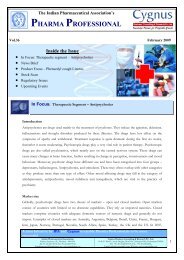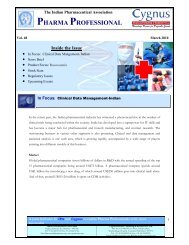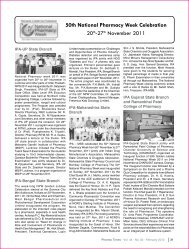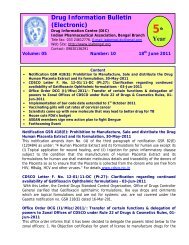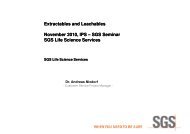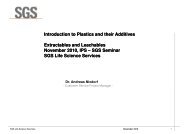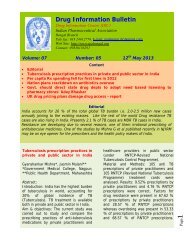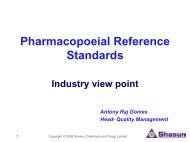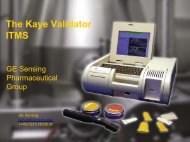Qualification of Equipment - Indian Pharmaceutical Association
Qualification of Equipment - Indian Pharmaceutical Association
Qualification of Equipment - Indian Pharmaceutical Association
Create successful ePaper yourself
Turn your PDF publications into a flip-book with our unique Google optimized e-Paper software.
Article<br />
<strong>Qualification</strong> <strong>of</strong> <strong>Equipment</strong> – A Risk-Based Approach<br />
S. M. Mudda*<br />
Executive Director – Technical & Operations,<br />
Micro Labs limited, Bangalore & Director <strong>of</strong> ISPE India Affiliate<br />
Why <strong>Qualification</strong>?<br />
The principle responsibility <strong>of</strong> a pharmaceutical manufacturer<br />
is to manufacture medicines <strong>of</strong> the highest quality that are safe<br />
and effective.<br />
The quality <strong>of</strong> the product is achieved through:<br />
‣ A well-designed product<br />
‣ Qualified facility and equipment<br />
‣ Current Good Manufacturing Practices<br />
‣ Qualified and trained personnel<br />
While the quality is achieved through all the above factors, it is<br />
important to note that selection and qualification <strong>of</strong> the equipment<br />
plays a significant role in ensuring consistency in the quality <strong>of</strong> the<br />
product. Consequently, qualification <strong>of</strong> equipment has become an<br />
essential part <strong>of</strong> a pharmaceutical manufacturer’s quality assurance<br />
systems and it is no surprise that GMP codes <strong>of</strong> all the leading<br />
regulatory agencies <strong>of</strong> the world include this activity.<br />
Regulatory Requirements:<br />
GMP regulations <strong>of</strong> all the leading regulatory agencies require<br />
that the equipment used for Manufacturing, Testing or holding<br />
and critical systems should be qualified prior to use as described<br />
below.<br />
WHO TRS 937, Annex 4, Appendix 6, <strong>Qualification</strong> <strong>of</strong> Systems<br />
and <strong>Equipment</strong>.<br />
‣ T h e c o n t i n u e d s u i t a b l e<br />
performance <strong>of</strong> equipment<br />
is important to ensure batchto-batch<br />
consistency. Critical<br />
equipment should therefore, be<br />
qualified.<br />
‣ Critical Quality impacting<br />
systems such as Water System,<br />
Air Handling System should be<br />
qualified.<br />
‣ Q u a l i f i c a t i o n s h o u l d b e<br />
completed before process<br />
validation is performed. The<br />
process <strong>of</strong> qualification should<br />
be logical, systematic process<br />
and should start from design phase <strong>of</strong> the premises, utilities<br />
and equipment.<br />
EU Guideline, Annex 15 <strong>Qualification</strong> and Validation<br />
‣ It is a requirement <strong>of</strong> GMP that manufacturers identify what<br />
validation work is needed to prove control <strong>of</strong> the critical aspects<br />
<strong>of</strong> their particular operations. Significant changes to the facilities,<br />
the equipment and the processes, which may affect the quality<br />
<strong>of</strong> the product, should be validated.<br />
‣ A risk assessment approach should be used to determine the<br />
scope and extent <strong>of</strong> validation.<br />
‣ Evidences should be demonstrated to support the validation<br />
and to verify the operating parameters and limits for the critical<br />
variables <strong>of</strong> the operating equipment.<br />
‣ Accordingly, each drug product manufacturer should identify the<br />
validation requirements needed to prove control <strong>of</strong> the critical<br />
aspects <strong>of</strong> the product and process.<br />
In accordance with these regulations, every manufacturer<br />
has to qualify equipment used for manufacturing and testing to<br />
demonstrate that it serves its intended purpose.<br />
Additionally, the calibration, cleaning, preventative maintenance,<br />
operating procedures and operator training procedures and records<br />
should be documented.<br />
It is important to note that selection and qualification <strong>of</strong> the<br />
equipment plays a significant role in ensuring consistency in the<br />
quality <strong>of</strong> the product<br />
In the next few paragraphs I intend to give a brief step-wise<br />
overview <strong>of</strong> the qualification process and then focus on the current<br />
issues before the industry.<br />
<strong>Qualification</strong> Process:<br />
The journey <strong>of</strong> equipment qualification starts from the User<br />
Requirement Specifications (URS) which are discussed with<br />
the vendor and based on the agreement signed. The URS shall<br />
include identified Critical to Quality Attributes and relevant Critical<br />
Process Parameters which in general consists <strong>of</strong> Process/ Product<br />
Requirements, Operational Requirements, GMP/GLP Requirements,<br />
Safety Requirements, Documentation Requirements, Discussion/<br />
Review/Comments etc.<br />
Design qualification: While designing a specific system or<br />
equipment the user requirements should be considered. Based<br />
on URS, the equipment design is discussed and equipment design<br />
qualification is undertaken.<br />
Installation qualification: After the design <strong>Qualification</strong>, the<br />
Factory Acceptance Testing (FAT) is undertaken followed by SAT<br />
(Site Acceptance Testing) after approval <strong>of</strong> the FAT. Once the<br />
equipment meets the SAT requirements, the systems and equipment<br />
should be correctly installed in accordance with an installation plan<br />
and installation qualification protocol. Installation qualification should<br />
include identification and verification <strong>of</strong> all system elements, parts,<br />
services, controls, gauges and other components.<br />
Operational qualification: Systems and equipment should<br />
operate correctly and their operation should be verified in<br />
accordance with an operational qualification protocol. Critical<br />
*Email Id: smm@microlabs.in<br />
Pharma Times - Vol. 44 - No. 11 - November 2012 17
operating parameters should be identified. Studies on the critical<br />
variables should include conditions encompassing upper and lower<br />
operating limits and circumstances (also referred to as “worst case<br />
conditions”). Operational qualification should include verification <strong>of</strong><br />
operation <strong>of</strong> all system elements, parts, services, controls, gauges<br />
and other components.<br />
Training <strong>of</strong> operators for the systems and equipment should<br />
be provided, and training records shall be maintained. Systems<br />
and equipment should be released for routine use after completion<br />
<strong>of</strong> operational qualification, provided that all calibration, cleaning,<br />
maintenance, training and related tests and results were found to<br />
be acceptable.<br />
Performance qualification: Systems and equipment should<br />
consistently perform in accordance with design specifications. The<br />
performance should be verified in accordance with a performance<br />
qualification protocol. The equipment is performing as per its<br />
intended use shall be demonstrated at this stage.<br />
Every manufacturer has to qualify equipment used for<br />
manufacturing and testing to demonstrate that it serves its<br />
intended purpose.<br />
Re-qualification: Re-qualification <strong>of</strong> systems and equipment<br />
should be done in accordance with a defined schedule.<br />
Calibration: The test equipments which are equipped with test<br />
instruments and are used for the control, weighing, measuring,<br />
monitoring and are critical for assuring the quality <strong>of</strong> drug<br />
substances and drug products should be calibrated according to<br />
written procedures and the established schedule.<br />
Preventive Maintenance and Cleaning: There should be<br />
a preventive maintenance program for all equipments. Similarly,<br />
cleaning <strong>of</strong> equipments is <strong>of</strong> utmost importance in the prevention<br />
<strong>of</strong> batch to batch and product to product contamination.<br />
Periodic Review <strong>of</strong> Validation/ <strong>Qualification</strong> Status: All the<br />
qualified equipments should be periodically evaluated to verify that<br />
they are still operating in a valid manner. There should be an annual<br />
review and conclusion should be drawn whether equipment stands<br />
in validated state or not.<br />
Change Control: Any changes in the equipment which can<br />
have impact on the product quality should be addressed through<br />
the change control system depending upon the nature <strong>of</strong> impact<br />
<strong>of</strong> the change on the product quality. The extent <strong>of</strong> requalification<br />
after the change should be justified based on a risk-assessment<br />
<strong>of</strong> the change.<br />
Current Status <strong>of</strong> Gmp Compliance:<br />
A review <strong>of</strong> the deficiencies related to qualification cited by all<br />
major regulatory agencies such as UK MHRA, WHO and US FDA<br />
reveals that there is a substantial scope for improvement by the<br />
industry on this front. Some <strong>of</strong> the examples <strong>of</strong> the deficiencies<br />
mentioned below will certainly draw our attention to this fact.<br />
A Major source <strong>of</strong> GMP deficiencies:<br />
‣ Acceptance Criteria: “The IQ/OQ for the Drum Hoop Mixer<br />
did not contain sufficient details with regard to the acceptance<br />
criteria or how the protocols were enacted. A discrepancy was<br />
identified but no explanation or impact was documented.”<br />
‣ Measurement Range: The blister packing machine range <strong>of</strong><br />
temperatures mentioned on the batch documents for forming<br />
and sealing had not actually been validated. Furthermore, the<br />
speed <strong>of</strong> the machine had not been specified.<br />
‣ List <strong>of</strong> Qualified <strong>Equipment</strong>: There was no list <strong>of</strong> equipment to<br />
aid in assessing the need for periodic evaluation <strong>of</strong> its validation<br />
status.<br />
‣ Validation Protocol: There was no pre-authorized validation<br />
protocol for the process.<br />
‣ Validation Report: No report had been written for the validation<br />
<strong>of</strong> the product. There was no conclusion stating that the<br />
validation had been successful.<br />
‣ <strong>Qualification</strong> Protocol: The complexity and criticality <strong>of</strong><br />
equipment and systems are <strong>of</strong>ten not taken into account when<br />
designing qualification protocols.<br />
‣ <strong>Qualification</strong> Protocol: No rationale was documented for the<br />
decision not to take all temperature data points into account<br />
when averaging the results, and only hourly results were taken<br />
and averaged.<br />
‣ <strong>Qualification</strong> Protocol: No rationale was documented in the<br />
qualification protocol for running the dryer under pressurized<br />
conditions and for only 6 hours, given that the routine drying<br />
processes were performed under full vacuum and for significantly<br />
longer periods <strong>of</strong> time (16 hours).<br />
Issues Before The Industry:<br />
Traditional Approach to <strong>Qualification</strong>:<br />
Historically, the pharmaceutical industry has been using standard<br />
equipment for manufacturing and testing <strong>of</strong> pharmaceuticals as<br />
opposed to custom-built equipment that is designed keeping the<br />
requirements <strong>of</strong> the product in mind. We therefore see standard<br />
equipment like, Rapid Mixer Granulator, Fluid Bed Dryers, Rotary<br />
Compression machines, Automatic capsule fillers <strong>of</strong> standard make<br />
being used in the industry. Over a period <strong>of</strong> years, addition <strong>of</strong> new<br />
parts for new functionality has been seen in limited processes, either<br />
for automated online monitoring <strong>of</strong> the process or occasionally<br />
for controlling the process to ensure that it runs within the predetermined<br />
limits.<br />
Nonetheless, not appreciating the real intent behind the GMP<br />
and regulatory expectations related to qualification activity, users<br />
are currently spending significant human efforts and financial<br />
resources in commissioning and qualification activities. These<br />
activities appear to be performed merely for compliance purposes<br />
since quite <strong>of</strong>ten it involves a mere repetition <strong>of</strong> verification already<br />
performed by the manufacturer.<br />
As stated earlier, since the same standard equipment is<br />
employed by different manufacturers for variable formulations<br />
<strong>of</strong> different requirements, the standard bookish approach for<br />
qualification makes the whole exercise inefficient since difference in<br />
the product and the process require different validation approaches<br />
including the level <strong>of</strong> documentation.<br />
It is therefore, imperative that the qualification study is designed<br />
taking into account the critical process parameters, identification<br />
<strong>of</strong> potential failures <strong>of</strong> the process control parameters leading to a<br />
defective product, including these parameters in the <strong>Qualification</strong><br />
Study and based on the outcome <strong>of</strong> the study designing appropriate<br />
in-process controls for monitoring the quality during manufacturing<br />
process.<br />
Absence <strong>of</strong> this approach obviously has lead to a number<br />
<strong>of</strong> deficiencies that are cited by all the leading global regulatory<br />
agencies as stated in the preceding paragraph.<br />
Pharma Times - Vol. 44 - No. 11 - November 2012 18
Inadequate URS:<br />
URS is the starting point <strong>of</strong> the qualification process that helps<br />
build an equipment <strong>of</strong> good design. The experience has shown that<br />
inadequately defined URS has been the fundamental weakness in<br />
the equipment qualification process.<br />
Very <strong>of</strong>ten, the user <strong>of</strong> the equipment converts the standard<br />
technical specification <strong>of</strong> the supplier into his URS.<br />
Contrary to stating the requirements <strong>of</strong> design <strong>of</strong> the equipment<br />
clearly based on the product and process needs, very <strong>of</strong>ten the user<br />
<strong>of</strong> the equipment converts the standard technical specification <strong>of</strong><br />
the supplier into his URS.<br />
Such is the lack <strong>of</strong> knowledge <strong>of</strong> this important quality impacting<br />
activity that the investigations done to identify the cause <strong>of</strong> a<br />
quality complaint <strong>of</strong> the product rarely point out the lack <strong>of</strong> good<br />
design and good qualification as the root cause thus, allowing the<br />
complaints to recur.<br />
Thus, we have a situation <strong>of</strong> having perfectly qualified equipment<br />
that is not able to produce a product <strong>of</strong> desired quality standards<br />
consistently.<br />
Thus, we have a situation <strong>of</strong> having perfectly qualified equipment<br />
that is not able to produce a product <strong>of</strong> desired quality standards<br />
consistently.<br />
Poorly Designed <strong>Qualification</strong> Protocols:<br />
Another commonly seen weakness is the inability to write a<br />
good protocol for qualification <strong>of</strong> the equipment. Although the<br />
protocol approval team is drawn from cross- functional members<br />
representing production, Engineering and Quality Assurance,<br />
<strong>of</strong>ten writing <strong>of</strong> the protocol is considered as a responsibility <strong>of</strong><br />
the engineering function alone. This disconnect between the<br />
process development, production and QA with the engineering<br />
team has lead to serious gaps in the qualification studies leading<br />
to inadequate qualification <strong>of</strong> the equipment and consequently<br />
earning critical GMP deficiencies.<br />
In a case <strong>of</strong> Performance <strong>Qualification</strong> (PQ) Study <strong>of</strong> a blender,<br />
the number <strong>of</strong> samples to be drawn, the sampling locations and<br />
the acceptance criterion for content uniformity were substantially<br />
different in the PQ Protocol from the Process Validation Protocol<br />
<strong>of</strong> the product that was used for qualifying the same equipment.<br />
The investigations revealed that both the protocols were written<br />
at different times and were signed by different individuals without<br />
consulting each other. Worst still, the study was concluded<br />
as satisfactory despite differences in parameters stated in the<br />
protocols since QA certified the PQ <strong>of</strong> the equipment without<br />
referring to the Process Validation Report and the corresponding<br />
Batch Record.<br />
Another weakness is poor facility <strong>of</strong> language that leads to<br />
badly written protocols and equally poorly written reports that clearly<br />
indicates that the entire study is carried out without getting into the<br />
depth <strong>of</strong> the subject.<br />
Example - Case Study:<br />
An automatic labeling system consisting <strong>of</strong> three key<br />
components, a labeling head, a conveyor for product transport, and<br />
an integrated control system each <strong>of</strong> which, in turn, having their<br />
own sub-components was used for labeling bottles on an integrated<br />
bottle packing line. Additionally, an Optical Character Reader was<br />
integrated with the machine to ensure the presence <strong>of</strong> label and<br />
also to confirm that the overprinted variable matter is readable and<br />
correct. Bottles with defective labels were in turn rejected by a<br />
Rejection System using a pneumatically operated pusher arm that<br />
worked at a required pressure level.<br />
The machine was qualified, set for use and was running<br />
satisfactorily until a market complaint <strong>of</strong> bottles with missing print<br />
and defective printing came as a surprise.<br />
A detailed root cause investigation was carried out on various<br />
aspects such as operations, handling <strong>of</strong> rejects, operation <strong>of</strong> the<br />
equipment etc. Finally, through a risk assessment carried out, the<br />
functioning <strong>of</strong> the rejection system came into light. It was revealed<br />
that defective packs were detected at the detection station but<br />
were not rejected by the pusher arm <strong>of</strong> the rejection system. The<br />
probable reason was exceptional pressure drop <strong>of</strong> the pusher arm<br />
that stopped the arm movement which could happen as a result <strong>of</strong><br />
a power failure or power fluctuations.<br />
Following CAPAs were initiated:<br />
a) UPS back-up to the system.<br />
b) Installation <strong>of</strong> pressure gauge to measure the pressure<br />
required for operating the pusher arm for rejecting the defective<br />
bottles.<br />
c) Installation <strong>of</strong> pressure switch which stops the machine while<br />
running, if the pressure <strong>of</strong> the pusher arm drops.<br />
For implementing the identified CAPAs the operating SOP <strong>of</strong><br />
the labeling machine and the batch records were revised to include<br />
instructions for setting, challenging and monitoring the pusher arm<br />
pressure that was adequate for proper functioning <strong>of</strong> the rejection<br />
system.<br />
The case study presented above confirms the points raised in<br />
the preceding paras.<br />
‣ It was a case <strong>of</strong> inadequate URS that did not identify the quality<br />
impacting nature <strong>of</strong> the rejection mechanism and therefore did<br />
not capture it as a parameter for qualification in the protocol.<br />
Thus, the optimum pressure required for operation <strong>of</strong> the pusher<br />
arm was neither defined nor qualified.<br />
‣ Since the failure <strong>of</strong> the operation <strong>of</strong> the pusher arm was not<br />
anticipated, no suggestion was made in the URS to provide<br />
for a system for dealing with such eventuality that was later<br />
implemented as a CAPA in the form <strong>of</strong> a pressure switch that<br />
would stop the equipment should the pressure drop below the<br />
required pressure.<br />
Delink between <strong>Qualification</strong> Report and Batch Record:<br />
The outcome <strong>of</strong> the qualification study should result in defining<br />
the critical process control parameters along with the operating<br />
range that can serve as monitoring tool during manufacturing<br />
process and will result in consistent delivery <strong>of</strong> quality product. The<br />
inability <strong>of</strong> capturing these parameters from the qualification report<br />
into the batch manufacturing instructions takes away the benefit<br />
the extensive qualification study.<br />
It is the responsibility <strong>of</strong> QA to ensure that the SOPs for<br />
Operation <strong>of</strong> the equipment capture the machine setting parameters,<br />
verification <strong>of</strong> these parameters by challenging them during the<br />
machine setting and thereafter including them as in-process controls<br />
and in-process challenges in the SOPs and in the Bach Records.<br />
Risk-Based Approach to <strong>Qualification</strong>:<br />
The qualification as practiced today appears to be performed<br />
from a lack <strong>of</strong> understanding <strong>of</strong> the GMPs related to equipment<br />
suitability leading to huge effort and documentation without<br />
Pharma Times - Vol. 44 - No. 11 - November 2012 19
corresponding benefit to the industry. Adoption <strong>of</strong> risk-based<br />
approach will ensure that a balance between the levels <strong>of</strong> efforts put<br />
in the qualification <strong>of</strong> equipment and benefit to the product quality<br />
is achieved. Thus, Risk-based qualification can improve quality and<br />
reduce validation efforts.<br />
International Society <strong>of</strong> <strong>Pharmaceutical</strong> Engineers (ISPE) is<br />
actively engaged in encouraging this approach and has come out<br />
with excellent guidelines towards this end.<br />
The ISPE White Paper “Risk Based <strong>Qualification</strong> for the 21 st<br />
Century” published in March 2005 propagates 10 Principles for<br />
Risk-Based <strong>Qualification</strong> that emphasizes focus on critical aspects<br />
for qualification while leaving out the others.<br />
ICH Q9, Quality Risk Management (QRM) provides a systematic<br />
process for the assessment, control, communication and review <strong>of</strong><br />
risks to the quality <strong>of</strong> the drug product across the product life cycle<br />
that can be applied to the qualification study. ICH Q9 Annexure-II<br />
provides the potential application <strong>of</strong> QRM.<br />
The guideline expects to determine the scope and extent <strong>of</strong><br />
qualification studies by applying the risk management principles<br />
and tools.<br />
Ten Principles for Risk-Based <strong>Qualification</strong><br />
a product under all the different perspectives <strong>of</strong>fering a significant<br />
contribution in the risk management process.<br />
Specification Phase: At the Specification Phase the user can<br />
communicate potential risks and the relevant impact to the supplier<br />
on Quality <strong>of</strong> the Product, Safety <strong>of</strong> the operator & the Business.<br />
This phase involves the risk identification and risk analysis.<br />
Design and Manufacture Phase: During Design and<br />
Manufacture Phase the Supplier shall identify critical parts and<br />
communicate these to users to evaluate the risks and provide<br />
additional controls and counter measure wherever necessary and<br />
finally accept the system design. This phase involves the evaluation<br />
<strong>of</strong> and control <strong>of</strong> the risk.<br />
It should be noted that while the technical part <strong>of</strong> the risk analysis<br />
can be performed by the supplier, it’s a responsibility <strong>of</strong> the user to<br />
evaluate the risks, to provide any required additional controls and<br />
finally to accept the residual risks.<br />
The IQ, OQ and PQ activities should be limited to systems and<br />
components with Direct Impact on the product quality. All the rest <strong>of</strong><br />
the system may be simply commissioned and managed according<br />
to Good Engineering Practices (GEP). As stated above the<br />
identification <strong>of</strong> critical parts is an outcome <strong>of</strong> the risk analysis.<br />
The Way Forward:<br />
The initiative <strong>of</strong> Risk-based <strong>Qualification</strong> was taken forward<br />
by the industry and ISPE under the advise <strong>of</strong> US FDA. On the<br />
publication <strong>of</strong> the White paper, ISPE worked with pharmaceutical<br />
companies and consulting companies to create an American Society<br />
<strong>of</strong> Testing and Measurement (ASTM) standard. The team’s goal<br />
was to integrate risk-based methodology conforming to the ICH<br />
Q8, <strong>Pharmaceutical</strong> Quality Systems and ICH Q9, Quality Risk<br />
Management standards. A new voluntary consensus standard,<br />
ASTM E 2500, Standard Guide for the Specification, Design, and<br />
Verification <strong>of</strong> <strong>Pharmaceutical</strong> and Biopharmaceutical Manufacturing<br />
Systems and <strong>Equipment</strong> was approved in June, 2007.<br />
ASTM E2500 is a Risk-based and Science-based approach to the<br />
specification, design, and verification <strong>of</strong> manufacturing systems<br />
and equipment that have the potential to affect product quality<br />
and patient safety.<br />
ASTM E2500 is a Risk-based and Science-based approach to<br />
the specification, design, and verification <strong>of</strong> manufacturing systems<br />
and equipment that have the potential to affect product quality and<br />
patient safety.<br />
The overall objective is to provide manufacturing capability to<br />
support defined and controlled processes that can consistently<br />
produce product meeting defined quality requirements.<br />
The application <strong>of</strong> QRM to equipment qualification is explained<br />
along side the ICH/QRM model below.<br />
Application <strong>of</strong> Quality Risk Management for <strong>Equipment</strong><br />
<strong>Qualification</strong><br />
The Key focus in the risk assessment phase is active<br />
engagement <strong>of</strong> the user with the supplier <strong>of</strong> the equipment that<br />
should lead to identification <strong>of</strong> Critical to Quality components and<br />
systems as described below. The supplier can provide a large<br />
number <strong>of</strong> support activities and services during the life cycle <strong>of</strong><br />
The guiding principle <strong>of</strong> the ASTM E2500 is to design the<br />
equipment by adopting the risk-based approach and manufacture the<br />
equipment by following the Quality Systems and Good Engineering<br />
Practices (GEP). The guideline strongly recommends, leveraging<br />
the information generated during the FAT SAT and commissioning<br />
stages to reduce the extent <strong>of</strong> IQ and OQ activities. In other words<br />
the ASTM guideline recommends verification <strong>of</strong> the data generated<br />
during the FAT, SAT and commissioning phase in lieu <strong>of</strong> IQ and<br />
OQ activities and go straight for PQ. The term ‘verification’ is used<br />
to describe both commissioning and qualification.<br />
There is a similarity between GEP and GMP. In both cases,<br />
Quality should be achieved by design, and not just tested at the<br />
end <strong>of</strong> the process. Embedding quality into an equipment design is<br />
mostly a supplier’s responsibility in a cooperative and trustworthy<br />
relationship with the user.<br />
Pharma Times - Vol. 44 - No. 11 - November 2012 20
Astm Process Flow:<br />
<br />
Pharma Times - Vol. 44 - No. 11 - November 2012 21
# Verification as <strong>Qualification</strong>:<br />
Benefits <strong>of</strong> ASTM E2500-07<br />
A recent case study on equipment selection, design and<br />
qualification using this approach demonstrated that a substantial<br />
amount <strong>of</strong> time and cost could be saved. The approach encouraged<br />
involvement <strong>of</strong> validation engineers from the URS stage. All<br />
functions were involved in performing risk assessment, identifying<br />
the individual user requirement, specifying the testing/verification<br />
requirements, assessment <strong>of</strong> the Site Acceptance / Factory<br />
Acceptance and application <strong>of</strong> increased knowledge <strong>of</strong> the QA.<br />
The application <strong>of</strong> this approach resulted in reducing a huge<br />
amount <strong>of</strong> time. The time required for vendor documentation was<br />
limited to six weeks. The information generated during the FAT/<br />
SAT was leveraged thereby reducing the IQ stage to 10 days from<br />
1-2 months and OQ stage to 3 days from 2- 3 months.<br />
The equipment delivery to qualification and commercial use<br />
was completed within a period <strong>of</strong> less than 3 months.<br />
RISK-BASED APPROACH:<br />
The information generated during the FAT/ SAT was leveraged<br />
thereby reducing the IQ stage to 10 days from 1-2 months and<br />
OQ stage to 3 days from 2- 3 months.<br />
Benefits <strong>of</strong> Risk-Based Approach<br />
It appears that regulators also will start accepting this<br />
approach very soon. In 2006, a new facility to manufacture two<br />
new products during facility and equipment qualification used<br />
risk assessments, commissioning, and process qualification<br />
approach to confirm the equipment was suitable for its intended<br />
use. The QA was involved in the risk assessments, approved<br />
the overall project quality plan, and conducted post-approval <strong>of</strong><br />
the process qualification protocols. There was no installation<br />
qualification/operational qualification per se performed. The<br />
inspectors inquired about this, and observed a much smaller<br />
volume <strong>of</strong> paperwork associated with this phase <strong>of</strong> the project.<br />
The approach used was explained to the inspectors, and the<br />
facility passed its inspection.<br />
CONCLUSION<br />
The risk-based qualification will be immensely beneficial to the<br />
industry since it demonstrably reduces the cost and time required for<br />
qualification. It is also good to see that even regulators are willing<br />
to encourage this initiative.<br />
However, it has to be understood that the success <strong>of</strong> this<br />
approach is dependent on the equipment manufacturer following<br />
his quality system and GEPs. Since the commissioning data<br />
is leveraged for qualification the standards for quality <strong>of</strong> this<br />
documentation should be established.<br />
The industry leaders, QA pr<strong>of</strong>essionals and engineers have to<br />
understand this concept and use it judiciously to ensure that the<br />
risk assessment is based on good science and supported by Good<br />
Engineering Practices.<br />
References<br />
1. EU GMP Guideline, Annexure 15<br />
2. <strong>Pharmaceutical</strong> Inspection Convention /Scheme (PIC/S)<br />
3. WHO TRS 937, Annexure-4<br />
4. ICH Q8 <strong>Pharmaceutical</strong> Development<br />
5. ICH Q9 Quality Risk Management<br />
6. ISPE White Paper – “Risk Based <strong>Qualification</strong> for the 21 st Century”<br />
(2005)<br />
7. ASTM E 2500 (2007), Standard Guide for the Specification,<br />
Design, and Verification <strong>of</strong> <strong>Pharmaceutical</strong> and Biopharmaceutical<br />
Manufacturing Systems.<br />
8. Risk Based <strong>Equipment</strong> <strong>Qualification</strong>: A User / Supplier Cooperative<br />
Approach, GAMP Italia <strong>Equipment</strong> Validation Work Group,<br />
<strong>Pharmaceutical</strong> Engineering, Volume 27, No. 3, May- June 2007<br />
<strong>Indian</strong> <strong>Pharmaceutical</strong><br />
<strong>Association</strong><br />
Dear Life Members,<br />
IPA secretariat is planning to provide a<br />
permanent Membership Card to every Life<br />
Member. Kindly send your<br />
• Name as it should appear on the card<br />
• Color photograph with signature across<br />
the photograph (minimum size 3.5 cm x<br />
3.5 cm)<br />
• Membership No. & Email ID<br />
• Blood group<br />
To<br />
the Hon. General Secretary<br />
<strong>Indian</strong> <strong>Pharmaceutical</strong> <strong>Association</strong><br />
Kalina, Santacruz (East), Mumbai-400 098.<br />
Pharma Times - Vol. 44 - No. 11 - November 2012 22



